Ngā tīpuna i Tamatea
Jul 7, 2020

Nā Helen Brown
Around 1pm on Sunday, 28 March, 1773 a small waka unua with carved taurapa and tauihu glided out of Te Unu-o-Momotu (Cascade Cove), the narrow bay on the south side of the entrance to Tamatea (Dusky Sound). As the waka rounded the point it came to a standstill as the eight kaihoe (paddlers) stared in amazement. Two days prior, the Resolution had slipped quietly into the fiord and anchored at Whetū (Pickersgill Harbour), a small sheltered bay to the north of Te Unu-o-Momotu. For 30 minutes the visitors on the strange vessel with tall masts and sails tried to entice them aboard. Eventually, as rain started, the kaihoe turned and paddled away. So began the encounter between our southern tīpuna, Captain James Cook, and the crew of the Resolution.
In following weeks, gifts, knowledge, and food were exchanged. While these experiences were no doubt profound for the tīpuna involved, when the Resolution departed six weeks later, it left barely a trace on our tribal memory. The visit was not inconsequential, but the benign nature of the actual encounter means that Cook has never loomed large in our tribal histories.
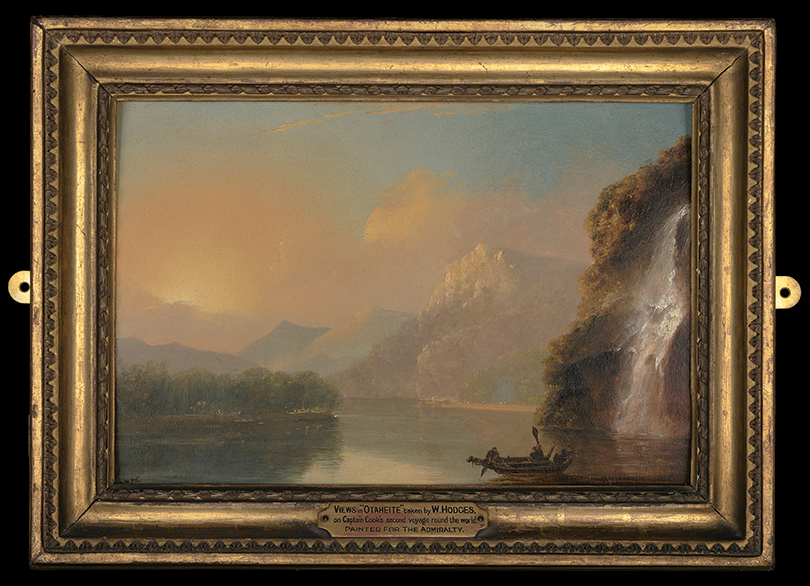
Above: Waterfall in Dusky Bay with Maori canoe, 1776, by William Hodges. Purchased 2019 with assistance from Lottery Grants Board, Tuia Encounters – 250 Fund. Te Papa (2019-0003-1).
Last year marked the 250th anniversary of Cook’s first arrival on the shores of Aotearoa. As communities around the country debated, commemorated, protested or ignored the occasion, Ngāi Tahu whānui could be forgiven for a degree of ambivalence. While we collectively acknowledge the mamae of all iwi, hapū, and whānau whose interactions with Cook had immediate and devastating consequences, including the loss of life, Cook’s arrival in New Zealand was of little direct consequence to the tangata whenua of southern Te Waipounamu. During his 1769-70 circumnavigation of New Zealand, Cook sailed the Endeavour down the eastern seaboard of ‘Toai Poonamoo’, around the southern tip of Rakiura and up the West Coast, but had no interaction with our people.
For Ngāi Tahu, the fiords of Te Rua o Te Moko (Fiordland), including Tamatea, represent the raised-up sides of Te Waka o Aoraki. The waka foundered on a submerged reef and its occupants, Aoraki and his brothers Rarakiroa, Rakiroa, and Rakirua, were turned to stone. They stand now as the highest peaks of Kā Tiritiri o te Moana (the Southern Alps).
En route, he erroneously mapped Te Pātaka o Rākaihautū as an island (Banks Island, later Banks Peninsula), assumed Rakiura was part of the mainland, and failed to sight our tribal maunga Aoraki, although his name was later memorialised in the English name ‘Mount Cook’, assigned to the mountain by Captain John Lort Stokes in 1851. Despite these oversights, Cook’s careful and detailed charts are otherwise extremely accurate, and comprise the first complete European map of the coastline of the Ngāi Tahu takiwā, indeed the entire country. In mid-March 1770, shortly before the Endeavour departed our waters, Cook sighted Tamatea, the largest fiord in New Zealand. It was dusk, and too late to attempt taking the Endeavour closer, but when Cook returned to New Zealand three years later on his second voyage in the Resolution, he determined to investigate the place he had marked on his map, somewhat unimaginatively, as ‘Dusky Bay’.
For Ngāi Tahu, the fiords of Te Rua o Te Moko (Fiordland), including Tamatea, represent the raised-up sides of Te Waka o Aoraki. The waka foundered on a submerged reef and its occupants, Aoraki and his brothers Rarakiroa, Rakiroa, and Rakirua, were turned to stone. They stand now as the highest peaks of Kā Tiritiri o te Moana (the Southern Alps). The fiords at the southern end of the alps were hacked out of the raised side of the wrecked waka by Tū Te Rakiwhānoa, in an effort to make it habitable for humans. The deep gouges and long waterways that make up the fiords were intended to provide safe havens on the rugged coastline, and were stocked with fish, forest, and birds to sustain travellers. For centuries before the mooring of the Resolution in 1773, our tīpuna ventured around the coastline to Tamatea during late summer and autumn on sealing, birding, and fishing expeditions. This history is borne out in the archaeology and place names recorded there. Today, our Ngāi Tahu fishermen, hunters, kaitiaki, conservationists and artists continue to have a close relationship with Tamatea.
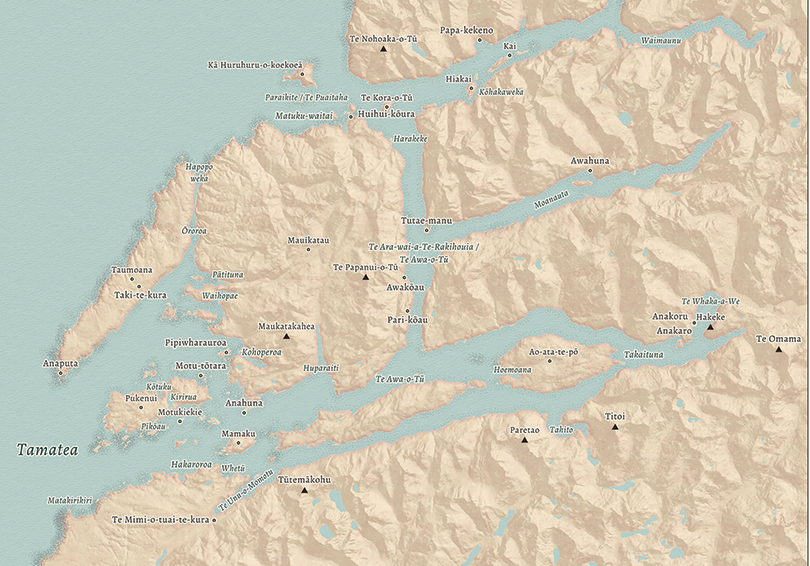
Above: Many of the place names of Tamatea have been researched and recorded by Kā Huru Manu, the Ngāi Tahu Cultural Mapping Project. Kā Huru Manu is dedicated to mapping the traditional place names and associated stories within the Ngāi Tahu rohe. Access Kā Huru Manu, the digital Ngāi Tahu Atlas, online at kahurumanu.co.nz.
While Cook’s sojourn in the autumn of 1773 is not recorded in southern Māori traditions, the journal accounts left by the crew of the Resolution provide small but revealing insights into the lives of the tīpuna, then living in this remote fiord. These include accounts penned by Cook, British mathematician and astronomer William Wales, and Georg Forster, the young German naturalist and ethnologist who accompanied his father, Johann, on Cook’s second voyage to the Pacific. Other accounts were written by English naval officer Richard Pickersgill, midshipman Bowles Mitchel, and Swedish naturalist Anders Sparrman, who was an assistant to the Forsters. While framed entirely from European perspectives, and therefore needing a critical read, these accounts include valuable observations on food preparation and descriptions of garments, wharerau and waka, and the earliest attempt at recording the southern mita (dialect). Most importantly, perhaps, the journals capture a sense of the personalities of the tīpuna involved, evoking their beliefs and values, and illustrating their overwhelming curiosity.
The detailed whakapapa of the tīpuna encountered by Cook at Tamatea is unknown. None of the journal accounts record their names although several researchers – mostly Pākehā – have creatively surmised their identities in the years since. While they may be anonymous, several sketches and paintings of these tīpuna exist. Produced by William Hodges, the official artist aboard the Resolution, these artworks constitute the earliest depictions of southern Māori by a European artist. Among the works is an oil painting acquired by Te Papa Tongarewa in 2019 – Waterfall in Dusky Bay with Maori canoe. This portrays a romantically rendered scene in Tamatea with a cascading waterfall, mountainous backdrop, moody waters, and luminous cloud formations. A small waka unua is being paddled in the foreground. According to Wales: ‘The canoe was composed of two small ones, hollowed out of a tree each, and fastened to one another about a foot asunder by cross pieces, which were lashed to both with bandages made of the hemp plant as we called it. The stems and stern posts rose much higher than the body of the canoe and the head was attempted to be carved like the upper parts of a man and two limpet shells were put for the eyes.’
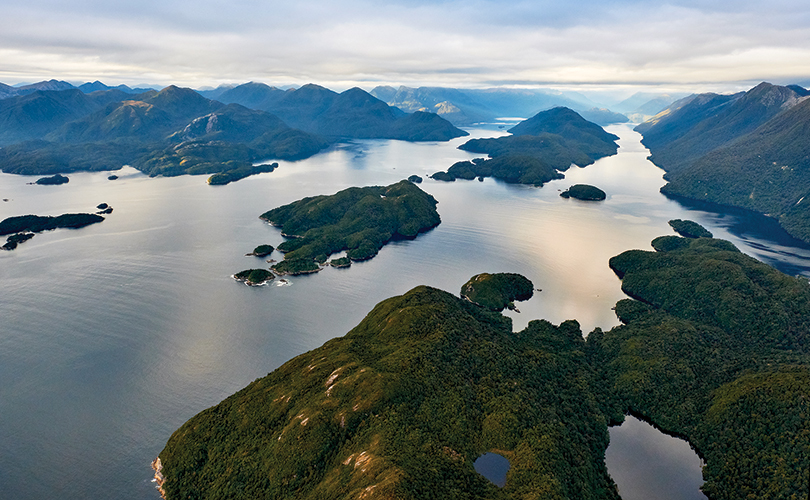
Above: Tamatea (Dusky Sound). Māmaku (Indian Island) is in the centre of this photograph with Whetū (Pickersgill Harbour) in the foreground to the right and the entrance to Te Unu-o-Momotu (Cascade Cove) in the foreground to the far right.
Photograph: Tony Bridge / Te Rūnanga o Ngāi Tahu Collection, Ngāi Tahu Archive, 2018-0311
Following their initial sighting of the Resolution, the tīpuna residing at Tamatea allowed another week to pass before making further contact with the visitors. In the meantime, Cook went in search of them. He discovered their waka hauled up on the beach in Te Unu-o-Momotu where he observed harakeke fishing nets, fishhooks, and several fish, ‘raw and broiled’ nearby. Wales described two ‘hutts’ nestled in the bush that were ‘four or five feet high, and nearly the same breadth’. Made of bark and harakeke, they were ‘round on the top like an arched vault and were built in the thickest part of the bushes.’ These were, of course, wharerau, the traditional temporary dwellings ubiquitous in southern Te Waipounamu. The kāinga nohoanga (campsite) was deserted, so Cook and his crew departed, leaving gifts inside the waka unua including a hatchet, a glass mirror, medals, and other trinkets. Cook returned daily to the site, hoping to catch another glimpse of the tangata whenua.
Then, on 6 April, a bearded kaumātua initiated further contact when he hailed a boatload of Cook’s men as they returned from a bird-shooting expedition. Wielding a taiaha and flanked by two women holding impressively long tao (bird spears), the man stood on a prominent point on the shores of Māmaku (which Cook named Indian Island) and challenged the visitors to approach. Drawing on the ethnographic knowledge he gained in earlier encounters with Māori, Cook threw handkerchiefs in a gesture of peace, and then stepped ashore, offering the kaumātua pieces of white paper. The two men then greeted each other in a hongi, and the wāhine stepped forward. Others from Cook’s party joined them ashore, including Hodges who immediately started sketching their ‘countenances’ in red chalk. The tīpuna described him as ‘tuhituhi’, a mark-maker (painter). Communication between the two parties proved difficult. However, the younger of the two wāhine completely dominated the ‘conversation’ leading Forster to write that her ‘vociferous volubility
of tongue exceeded everything we had met with’. Other accounts of this episode concur, pointing to the familiar and enduring power of mana wāhine in southern Te Waipounamu!
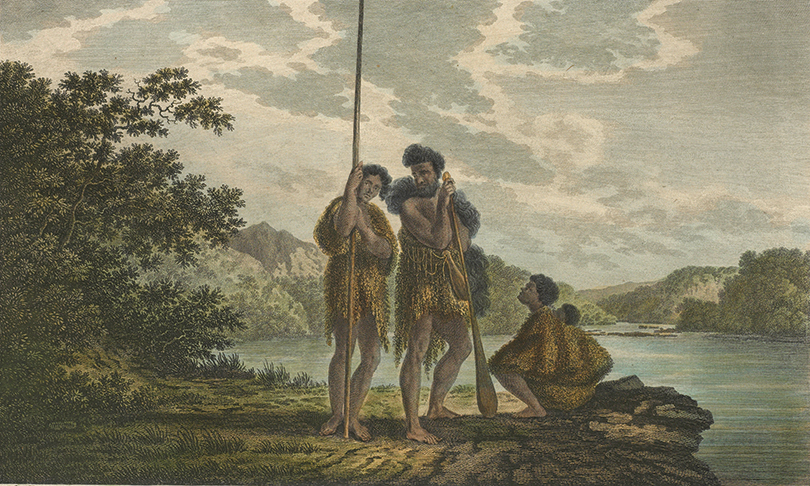
Above: Family in Dusky Bay, New Zeland, 1777, hand-coloured engraving by Daniel Lerpiniere after William Hodges. Gift of Horace Fildes, 1937. Te Papa (1992-0035-1773).
Group portraits of this family were later depicted in a series of engravings, which detail the tao held by the women, the taiaha leant on by the kaumātua and the patu parāoa secured at his waist. The garments worn are also suggestive of the ‘ahou’ (kāhu huruhuru or feather cloak) and ‘buggy-buggy’ (pake or rain cape) described by Wales. The whānau showed the visitors their wharerau and exchanged gifts.
The next day a group from the Resolution returned to Māmaku and met the entire whānau which comprised the kaumātua, two women (understood by Cook to be his wives), a young woman (possibly his daughter), a teenage boy, and three or four small children. Group portraits of this family were later depicted in a series of engravings, which detail the tao held by the women, the taiaha leant on by the kaumātua and the patu parāoa secured at his waist. The garments worn are also suggestive of the ‘ahou’ (kāhu huruhuru or feather cloak) and ‘buggy-buggy’ (pake or rain cape) described by Wales. The whānau showed the visitors their wharerau and exchanged gifts. As Cook’s crew prepared to leave, the kaumātua indicated his desire for Cook’s full-length red woollen boat cloak. That night the Resolution’s sailmaker made a new cloak to order, and Cook presented it the next day. Forster wrote: ‘The captain wore the new cloak of baize on his own shoulders, and now took it off and presented the man with it; he, on his part, seemed so much pleased with it, that he immediately drew out of his girdle a pattoo-pattoo, or short flat club made of a great fish’s bone, and gave it to the Captain in return for so valuable an acquisition’.
In the following days the whānau approached the Resolution and set up camp on the neighbouring shore, where they prepared meals, and sometimes stayed overnight. Members of Cook’s crew played the fife and bagpipes and beat a drum, but the tīpuna were largely unmoved. The kaumātua seemed most intent on obtaining one of the ship’s tenders that he watched closely as they plied between the Resolution and shore. Wales noted the man ‘seemed almost continually lost in wonder at the construction of the ship and boats and whenever any of them came near him he examined them in the strictest manner, particularly how they were put together.’ His interest in the technologies proffered by the visitors was also borne out in his personal testing of a pit saw and musket, and his keen acceptance of hatchets and spike-nails as gifts.
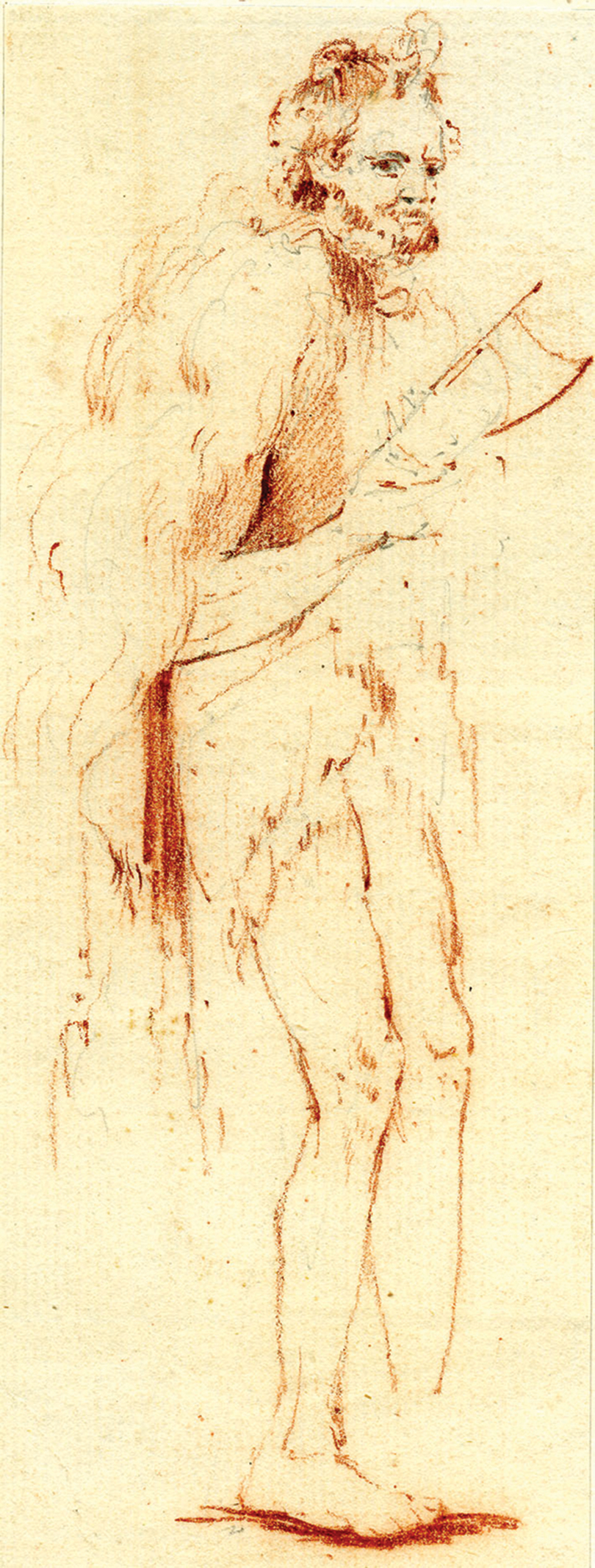
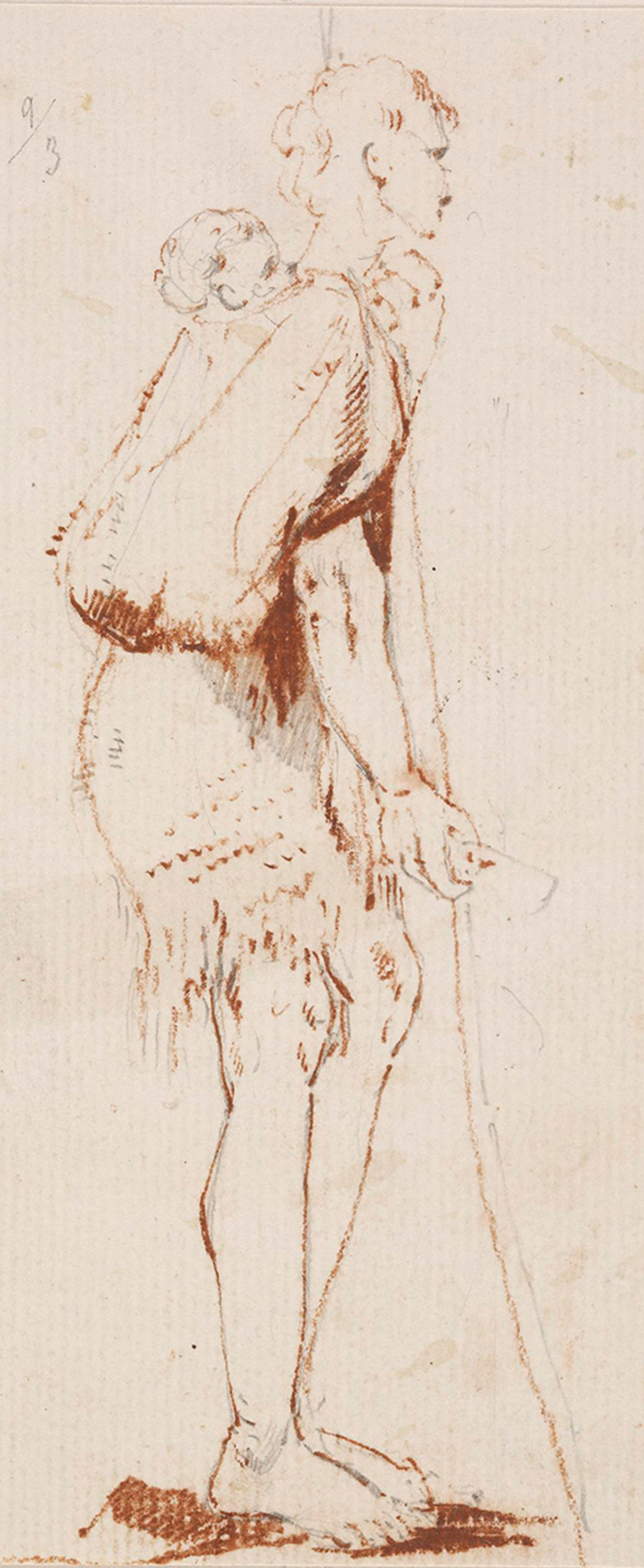
Original drawings by William Hodges. Above top: A Maori man, holding a hatchet; WL standing to r. 1773 Red chalk, over graphite. Above: A Maori woman, carrying a child in a sling over her back. 1773 Red chalk, over graphite. © The Trustees of the British Museum.
Eventually he and his daughter gained confidence to board the tall ship. After delivering a requisite karakia, the pair stood on the quarter-deck and admired all they saw. Cook remarked that the ship’s company did not occupy the man’s attention as much as the ship’s deck on which he repeatedly stamped his feet, apparently testing its strength. They spent the whole morning aboard and Wales recorded they ‘visited every part of the ship with which they seemed much delighted; but most particularly so with a few sheep which we had yet left; and the cats’, whose fur they insisted on stroking backwards. Around noon, the man and his daughter departed and the entire whānau was not seen again. Cook and his men later encountered another group of equally curious tīpuna on a duck-shooting expedition in another part of the fiord. However, they did not enjoy the same prolonged interaction.
On 29 April, the Resolution weighed anchor at Whetū, and began a staged departure from the fiord, eventually sailing out of Tamatea on 11 May. A detailed map of ‘Dusky Bay’ was published by Cook in 1777, marking the way for the first sealing gang who landed at Tamatea in 1792. Other sealers followed, and whalers came in their wake. Southern Te Waipounamu was never the same. As for the tīpuna who met Cook, we have no clue to their precise identity, but as Tā Tipene O’Regan said: ‘Kāi Tahu today are the inheritors of whatever dreams they had.’
Tamatea: He Tūtakinga Tuku Iho | Legacies of Encounter exhibition at Te Papa Tongarewa presents Hodges painting ‘Waterfall in Dusky Bay with Maori canoe’ in conversation with taonga and artworks. Te Papa worked with Ngāi Tahu ki Murihiku and the Ngāi Tahu Archive team to develop the content for the exhibition which is on now at Te Papa.